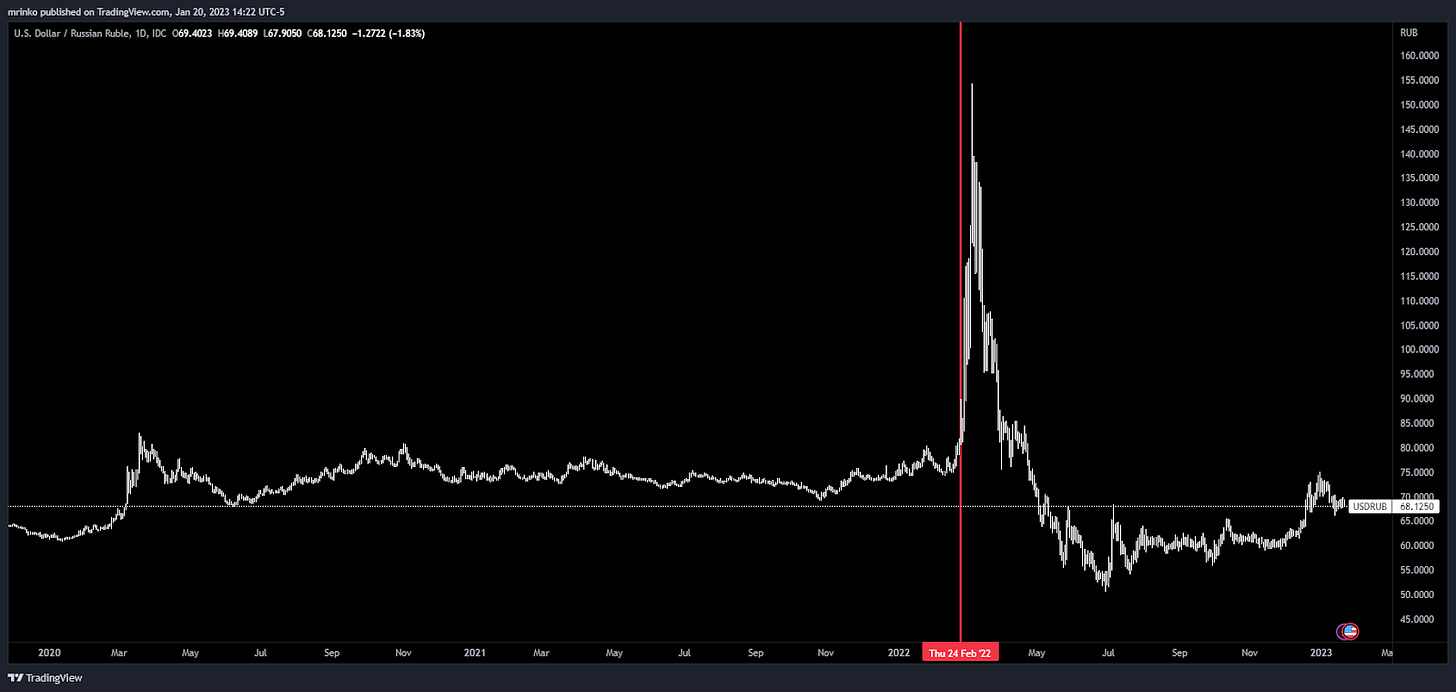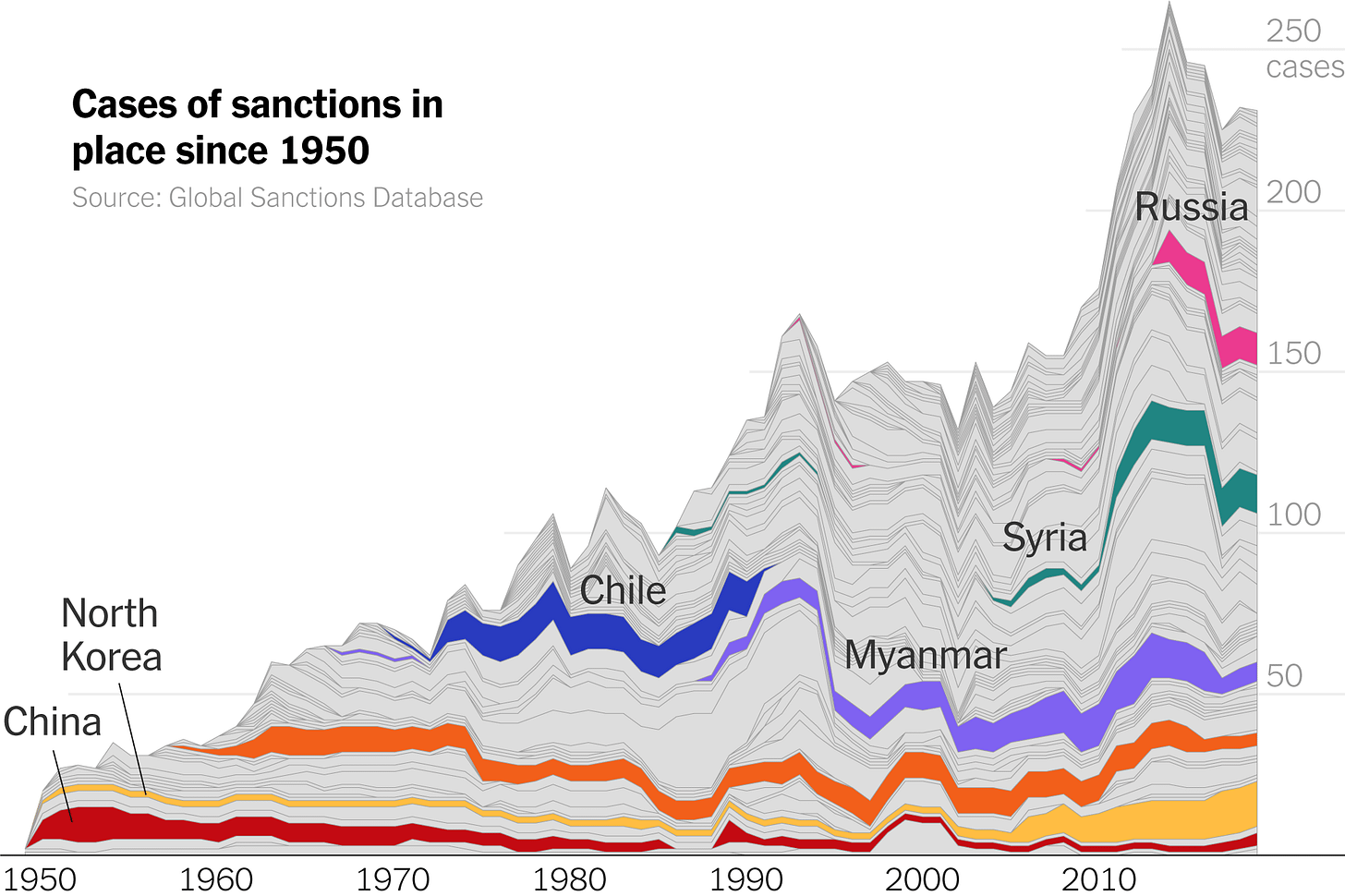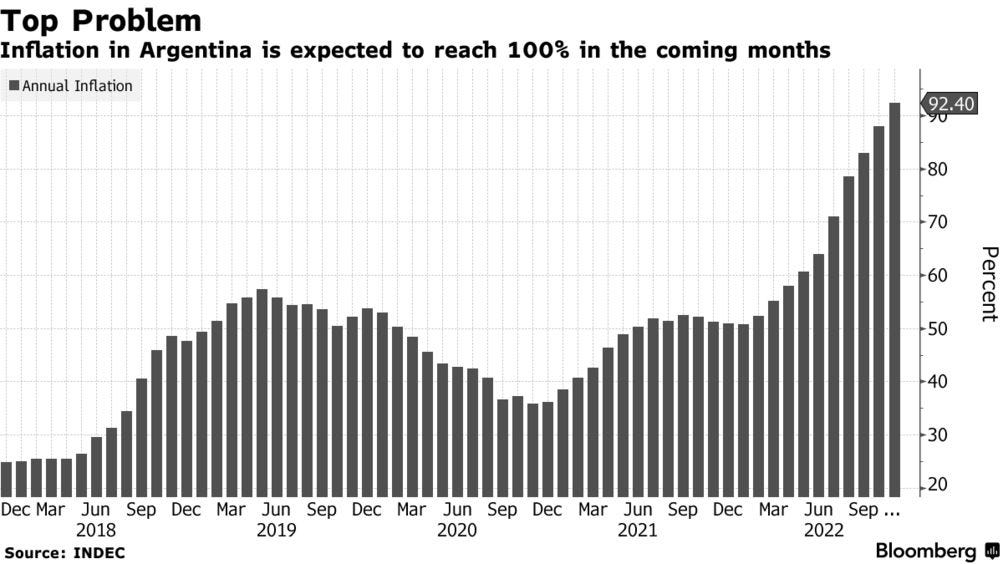Crypto's Role in the New Cold War
Upon observing the detonation of the world’s first atomic bomb, J. Robert Oppenheimer, father of the Manhattan Project, quoted Hindu scripture, saying: “Now I am become Death, the destroyer of worlds.”
Christopher Nolan’s upcoming film ‘Oppenheimer’ looks to be a must watch
Upon observing the detonation of the world’s first financial atomic bomb, Wally Adeyemo, chief architect of the said bomb, calmly stated he was “prepared to do more.”
Mr. Adewale ‘Wally’ Adeyemo is the 15th U.S. Deputy Secretary of the Treasury
So, what to make of the stark difference in reactions? At the risk of stating the obvious, an actual atomic bomb is, well, loud and scary. If you get too close, you will die. Conversely, a financial nuclear bomb is less, uhh, in your face? Its ‘explosion’ results in the click of a keyboard, not a radiation-laced mushroom cloud.
The invention of nuclear weapons in the mid-20th century had a profound impact on the world. They led to the development of a doctrine of mutually assured destruction, which helped to maintain a balance of power between the US and the Soviet Union during the Cold War and ultimately ushered in the Long Peace.
Financial weapons of mass destruction will be similarly impactful, albeit, in more subtle and less obvious ways. This essay will explore the second and third-order effects on financial markets, geopolitics and crypto of one of the most consequential yet overlooked events of 2022.
Of course, one key difference between the two ‘nukes’ is that when someone says “nuclear bomb,” everyone knows exactly what they’re talking about. But when someone says “financial nuclear bomb,” literally nobody knows what they’re talking about.
“Financial nuclear bomb” - Midjourney
So, let’s be explicit. The financial nuclear bomb that Mr. Adeyamo unleashed was the freezing of a large part of Moscow’s $643 billion worth of foreign currency reserves.
These “reserves” were foreign currencies like dollars, euros, and yen sitting in financial institutions outside of Russia. With the click of a button, the West froze these assets and effectively declared economic war on Russia.
This unprecedented sanction caused the ruble to briefly tumble, but, thanks to record high energy revenues, it rallied to finish as one of 2022’s top-performing currencies.
$USDRUB – red line denotes Russia’s invasion of Ukraine on Feb. 24th, 2022
The seizure of Russia’s reserves ignited fierce criticism abroad, as it revealed America’s hypocrisy and willingness to break the very rules of the liberal order it once wrote. However, the sanction itself was not entirely novel. The US has sanctioned central banks before: North Korea, Iran, and Venezuela. But these are niche players on the world stage. Russia marked the first time the weapon was used against a major economy and the first time as part of a war – especially a war involving a leading nuclear power.
For many countries, the Russia sanction was the final straw in a long line of US abuses. In the years following World War II, America has increasingly used its dominant position in global finance as a cudgel. As American voters have grown tired of military interventions and “forever wars,” financial warfare has stepped in to fill the void.
In the absence of an obvious military or diplomatic option, financial sanctions have become an all too easy means of power projection.
“Keyboard warfare” is cheaper and carries less political risk than bombs or troops
The potency of America’s sanctions derives from the omnipresence of the US dollar. Today, central banks hold about 60% of their foreign exchange reserves in dollars. In foreign exchange markets, dollars are involved in nearly 90% of all transactions.
As a result, it's near impossible for countries to do (legitimate) business without touching the US financial system in today’s globalized economy.
The existential question of “whether the US will freeze and confiscate our assets” will ultimately lead countries to conclude that they must do more to protect their assets against the whims of US policymakers.
This will inevitably lead to some form of de-dollarization and the repatriation of assets sitting outside sovereign borders. Outside money, as noted Credit Suisse strategist Zoltan Poszar calls it, will boom.
Countries like North Korea and Iran already employ this approach out of necessity, but non-aligned countries and even countries allied with the US are likely to follow suit. Here, the nuclear bomb analogy appears instructive yet again.
During the Cold War, both sides spent a prodigious amount of money stockpiling nukes.
We’re taught that the US won because it drove the Soviet Union into bankruptcy. This is true but fails to tell the full story. After all, nuclear bombs didn’t tear down the Berlin Wall, people did.
The US won the Cold War because it had better ideas, not better nukes.
Financial weapons of mass destruction create a new kind of recursive, escalatory cycle. Russia, along with other countries wary of US overreach, will increasingly shift away from trading in dollars. They will opt to hold assets that are beyond the reach of US enforcement, like precious metals, commodities and a basket of non-dollar currencies.
This will lead to severe handwringing in Washington. Policymakers will feel tempted to lash out and escalate against dollar dissenters to appear “strong” on the world stage.
The United States may be able to coerce smaller countries into continued dollar dependence, but hawkishness will fall flat on the larger BRICS – Brazil, Russia, India, China, and South Africa – of the world.
Instead of resorting to bully tactics, the game theory optimal strategy for the US is to double down its asymmetric advantages. Similar to video games where characters have unique attributes that others lack, countries have their own set of relative strengths and weaknesses. Some enjoy abundant natural resources, while others have access to critical ports and shipping routes. The US has the dollar: the most widely desired currency in the world. It should “open source” the dollar, not build walls around it.
Argentina, a nation where the US is currently competing with Russia and China for influence, provides a compelling case study of the dollar’s influence.
On one hand, the Argentinian government is reportedly in talks with Brazil to establish a euro-style common currency. A move officials hope will boost regional trade and reduce reliance on the dollar.
However, just as the Argentinian government is trying to move away from the dollar, its people are moving towards it. After decades of runaway inflation, Argentinians have learned to save in other countries’ currencies and their favorite is the US dollar.
The only problem is dollars are hard to come by on the streets of Argentina. The government imposes strict capital controls that make moving money in and out of the country challenging. Crackdowns on dollars are common as Buenos Aires views the greenback as a threat to the stability of the hyperinflationary Argentinian peso.
As a result of hyperinflation and strict capital controls on US dollars, the Argentinian people have turned to some unconventional alternatives to store their wealth.
Bricks – yes, actual bricks – have become a popular savings mechanism for Argentinians. The value of bricks is fairly stable, and they’re useful to a family building a house. Argentina lacks a functioning mortgage industry, so buying a pallet of bricks with each paycheck is an effective way to pay for a home in installments.
As one might imagine, keeping your life savings in bricks is, like, not ideal. They present challenges. For starters, they take up a lot of space. Worse, they’re at constant risk of theft and damage; and if something happens, the bricks are not insured or protected by any institution; they’re just, well, gone.
Acting out of necessity, Argentinians have started experimenting with more avant-garde methods of storing wealth.
Stablecoins have exploded in popularity in Argentina and across broader Latin America by offering access to a dollar-backed currency that’s out of the government’s reach.
Despite the best efforts of both the Argentinian and US governments, stablecoins have found immediate product-market fit on the streets of Argentina. Thanks to public blockchains, any Argentinian with an internet connection can now access US dollars. Crypto unlocks a step change in dollar availability that was simply not possible before.
Argentina’s bottoms-up, popular embrace of stablecoins is strikingly in-line with crypto’s decentralized ethos. It’s also reminiscent of how the US won the last Cold War: by unleashing the power of the free market and letting the people do they thang.
If US policymakers are still unconvinced by stablecoins’ popularity in Argentina, they should take a closer look at the de facto currency of crypto. Spoiler: it’s not BTC or ETH.
If you want to know an exchange’s volume, you can check CoinGecko. It looks like this:
Note that all the trading volumes, across all exchanges, are quoted in US dollars. This is noteworthy because CoinGecko isn’t based in the US, it’s in Kuala Lumpur, Malaysia.
More interesting is even if you use a Japanese IP address and set the language to Japanese, CoinGecko shows you trading volumes in units of… US dollars.
In fact, nearly everything in crypto is quoted in US dollars, regardless of the country or token. Volumes, prices, and market caps – all quoted in USD.
Ask anyone what BTC is trading at and they’ll probably say ~$23k – even if they spend a different currency when they go to the store.
Perhaps most importantly, it’s not just a question of how crypto is quoted, it’s also how it trades. On Binance – the world’s largest spot venue – the top 10 markets by volume all trade against BUSD or USDT – both stablecoins tracking, well, the US dollar.
Stablecoins are the settlement currency of crypto. The vast majority of trades – whether spot, futures, or OTC – are settled not in BTC, nor SWIFT payments, but in stablecoins.
So, what are the largest stablecoins?
All of the stablecoins above are pegged to the dollar. In fact, >99% of all issued stablecoins are pegged to the USD. The US dollar is the world’s currency, and for right now, it’s also crypto’s currency.
As Xi Jinping likes to say, “great changes unseen in a century” are afoot. Covid, the largest war in Europe since WWII, and the re-emergence of Great Power competition all conspire to erode the dollar’s hegemonic position in global finance.
The dollar-based order is under attack from two vectors: de-dollarization efforts and central bank digital currencies. We’ve already discussed de-dollarization efforts like Latin America’s common currency plan and the China-Saudi oil-for-yuan talks.
CBDCs could turbocharge these efforts. Unsurprisingly, China has aggressively promoted its digital yuan domestically with plans to internationalize in time.
Given that financial sanctions are implemented through the balance sheets of western banks, and that these institutions form the backbone of the system that underpins the dollar, using the same network to challenge the dollar makes little sense. Better to instead build an entirely new network, which a blockchain-based digital yuan enables.
If the US hopes to keep pace with China’s CBDC development, counter de-dollarization efforts, and control the next evolution of the global financial system, a new monetary strategy is needed.
As discussed, relying solely on coercion is a hopefully flawed approach. But building a US government CBDC (“US Gov Coin”) is risky too, as it will presumably get bogged down in bureaucracy, like the REAL ID.
The REAL ID program started shortly after 9/11 – over two decades later and it’s still in limbo
An alternate path is to outsource development to private industry – the SpaceX model – and bring a private stablecoin, like Circle’s USDC, into the regulatory framework.
As the US continues to face blowback from its decision to ‘go nuclear’ on Russia’s reserves, countries will accelerate plans to de-dollarize and adopt other settlement systems like blockchain-based CBDCs. The US faces a binary choice: escalate against the dollar doubters or win them over with fresh ideas.
A dollar-backed, private stablecoin is a fresh idea. Not only will it cement the dollar’s reserve currency status in crypto, but it will help the US achieve critical geopolitical goals. Vive la stablecoin, Vive la Pax Americana.












































